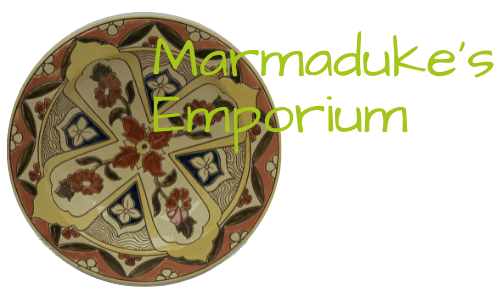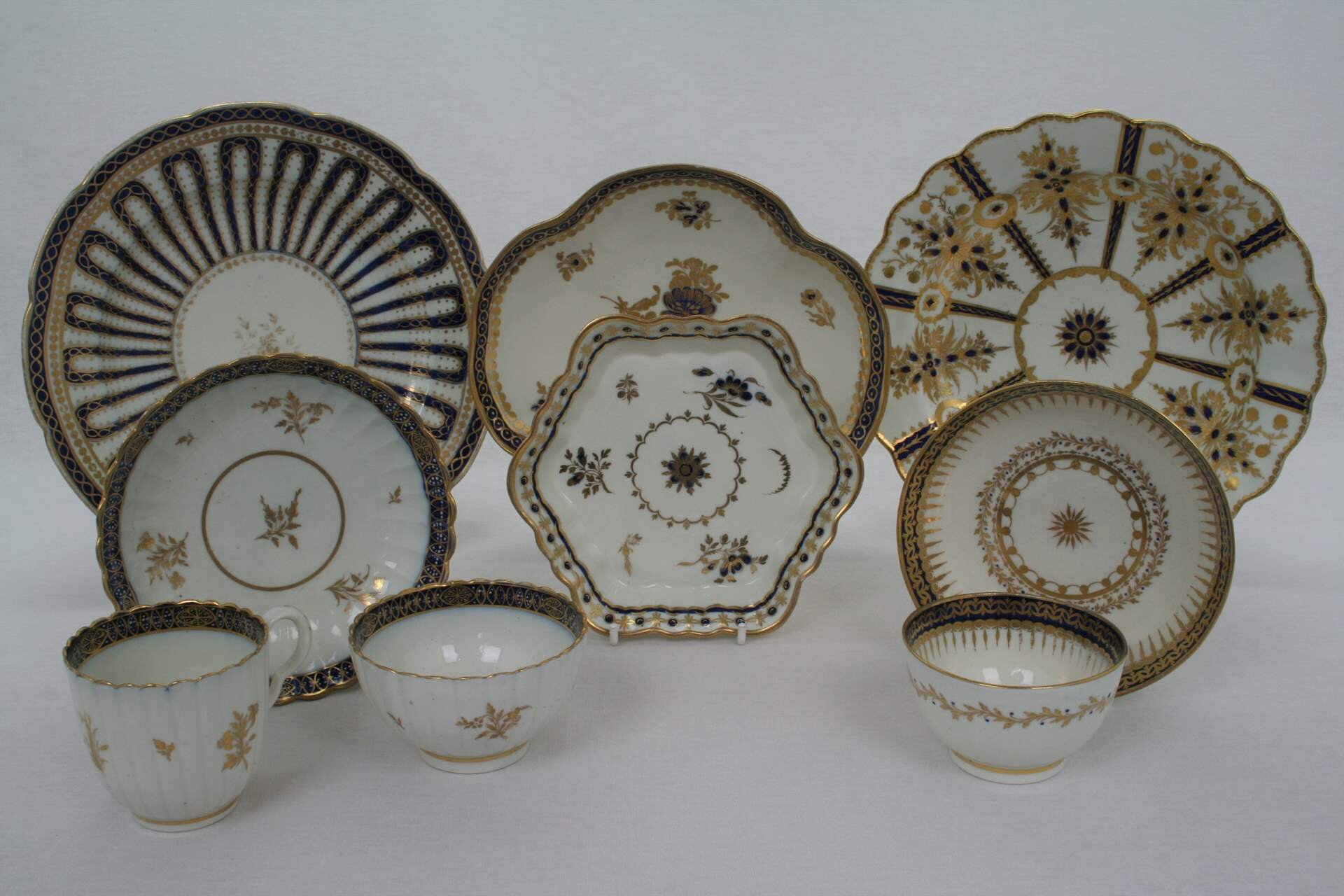
Caughley
The Caughley or Salopian Porcelain Manufactory.
Ambrose Gallimore had a background in the Potteries and took out a lease on a local potworks in Caughley (pronounced Calf-ley) just south of Broseley in the 1750’s and was thought to have made traditional useful wares. In around 1772 he went into partnership with Thomas Turner who had worked with Worcester Porcelain. Thomas Turner was by repute very much the driving force and transformed the pottery into a porcelain manufactory and by 1775 they were well established producing soapstone porcelains with under glazed blue and white patterns in the French and Chinese styles.
A Caughley leaf shaped pickle dish in the Aster pattern.
The Aster pattern is believed to be one of the earliest patterns introduced by Caughley, dating to 1775 or so.
Pretty sparrow beak creamer or milk jug hand painted in Chrysanthemum pattern
Large tankard in the parrot pecking fruit pattern
They produced a large range of tea, dinner and dessert services together with mugs, jugs, inkwells and many others items. One of most popular patterns that cemented the success of the Caughley factory was the Fisherman pattern, originally called the Pleasure Boat pattern in the 18th Century. Other factories produced the pattern and today it is important to collectors as it is possible to distinguish Caughley pieces from the other factories, even when there are no factory marks to the reverse. One of the most “popular” attributes is that the seated fisherman to the top left of the pattern has just caught a fish, so the fishing line is tight on Caughley pieces, whereas on Worcester porcelain examples of the pattern the fish has just got away, the line is “wiggly.” How apt!
Also, the Fisherman pattern was reproduced on a wide range of objects from artichoke cups to wash basins.
A superb Caughley baking dish in the Fisherman pattern.
Caughley Fisherman pattern dessert dishes in three different sizes.
Rare Caughley oval pot for potted meat or shrimps in the Fisherman pattern. Back in the pre-refrigeration days of the late 18th Century many methods were used to keep food from going off, one of which was the process of potting. The ingredients were prepared into a paste and then sealed in pots by covering them with melted clarified butter which kept air out and the freshness in.
Caughley egg drainer in the Fisherman pattern. For many years it was a subject of debate on what these drainers were actually used for but in records from more than one factory they were often sold with egg cups as part of a breakfast set, so it is assumed they were for draining eggs.
Decoration was generally limited to the under glazed blue and white patterns, with the gilding and enamelling completed externally. By the late 1780’s they entered into a formal arrangement with Robert and Humphrey Chamberlain of Worcester and as tastes changed a larger proportion of the designs became more reliant on gilding and so more of the factory’s output passed through the hands of Chamberlains and other independent decorators.
Caughley decorated with blue and gilt patterns.
Wasters were found at the factory site where the underglazed blue parts of the designs are present.
Some collectors are a little sniffy about this type of decoration but when it’s as good as this!
“If you think you have something that we would like to add to the collection please contact us!”

By 1793 Chamberlains started producing their own porcelain and the arrangement with Caughley ended, so Caughley had to expand so they could take on more of the decoration themselves and they introduced simple polychrome designs similar to New Hall. They also started experimenting with other types of porcelain that wasn’t very successful. Business was certainly on the wane and although Turner allegedly blamed ill health, he probably thought the end was in sight and in 1799 he sold up to the Coalport partnership of John and Richard Rose and Edward Blakeway. Coalport carried on using the factory for a few years but eventually it was taken down and the building materials reused.
Caughley tea pot stand handpainted in the Tower pattern dating from the 1790’s.
It is one of the patterns introduced when the business was on the wane. Was labour really cheaper to paint these new patterns rather than get copper plates engraved?
Even up to fairly recently Caughley porcelains were seen as second rate, even as contemporary fakes of Worcester but that has now been shown to be incorrect. Many forms were produced at Caughley that bore no relationship to those made at Worcester, in fact after 1775 the range made at Caughley was more diverse. Many poorer quality blue and white wares that used to be described as “must have been made at Caughley” have been proved by excavation to have been made at Worcester!
Caughley was certainly a leading manufacturer in those early days of English Porcelain and were commercially successful, meeting the demands of the burgeoning middle-classes as well as capable of producing pieces for the aristocracy.
Much Caughley is marked but then again much isn’t! The most common marks are an under glazed printed S or a C, which to this day is often confused with the Worcester Crescent mark. Other identifying attributes such as the colour of the paste or shape of the foot rim have their supporters but I take them with a pinch of salt. Just to keep us guessing Caughley didn’t mark pieces at all after 1792 or so, so late patterns such as the Tower pattern wasn’t marked.
Caughley collectors benefit greatly from the forming of the Caughley Society, a registered Charity that aims to educate and promote the factory and has put on exhibitions, published a pattern book and a newsletter four times a year. I would certainly encourage anyone with an interest in Caughley or a wider interest in 18th Century English Porcelain to become members.
If you visit the site today, the only clue that a once hive of industry existed there, in such a rural landscape, is a beautiful memorial funded by the Caughley Society.
One of my favourite pieces, I don’t know why. It’s a tureen stand in the Willow Nankin pattern dating from 1780 or so. It has an “dry” or unglazed base and is unmarked.











